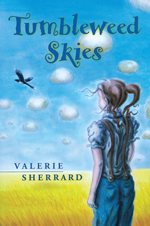Your guide to recently released books, CDs and other teaching resources. For additional reviews of French-language resources, visit Lu, vu, entendu. With the exception of some classroom sets, items reviewed are available on loan from the Margaret Wilson Library at the College. Contact Olivia Hamilton at 416-961-8800 (toll-free in Ontario 1-888-534-2222), ext 679, or e-mail library@oct.ca.
Teaching Fairly in an Unfair World
by Kathleen Gould Lundy
This is an easy-to-use resource that focuses on empowering diverse learners in our multicultural classroom communities. It contains a wealth of knowledge and practical solutions that guide educators toward creating inclusive classrooms at both the elementary and secondary levels. The author uses anecdotal and theoretical supports to design activities that cover character education, diverse curriculum, building community and critical thinking.
Respected educators like Howard Gardner and James Bank are cited to provide context to the activities, which are explained thoroughly and clearly. Appendices accompany each lesson for quick and easy implementation. Fifty cross-curricular activities at the end of the book are classroom ready, providing instant access to empowering diverse learners.
Besides targeting classroom teachers, the author looks at the roles of leaders and administrators and encourages them to examine and reflect on their own inclusive pedagogies. By building collegiality, collaboration and consensus, she suggests, we can create a platform for students whose voices have too frequently been silenced in today’s schools.
Teaching Fairly in an Unfair World, Pembroke Publishers, Markham, 2008, softcover, ISBN 978-1-55138-231-9, 159 pages, $24.95, tel 905-477-0650 or 1-800-997-9807, www.pembrokepublishers.com
Chadwick Low, OCT, is an ESL and Aboriginal consultant with the Dufferin-Peel Catholic DSB in Mississauga.
 Creating Safe School Environments
Creating Safe School Environments
by Peter G. Jaffe, Claire V. Crooks and C. Lynn Watson
This resource is geared to principals and vice-principals, but its step-by-step strategies for creating a safe school are applicable to all educators. The book deals with issues of violence, including bullying, harassment, racism and sexism. It provides a framework for action, following tried and true models for change that were developed for health-care facilities but that – with some modification – are applicable to schools as well.
To begin the process of fostering a safe school environment, engagement with all sectors of the community must be sought, so that everyone becomes a stakeholder. The book shows how an audit of the physical environment has an impact on creating a protected place to learn and suggests amendments to both interior and exterior spaces to accomplish that goal. It also makes a case for involving custodial staff and police-services representatives.
Despite the many demands placed on school leaders in responding to myriad daily occurrences, the authors encourage a shift from a reactive to a proactive approach, so that challenges to safety that diverse school populations might present can be anticipated. By accepting that mistakes inevitably occur, educators can plan for, rather than be derailed by, setbacks that might undermine the whole initiative.
Creating Safe School Environments: From Small Steps to Sustainable Change, Althouse Press, London, 2009, softcover, ISBN 978-0-920-354-70-4, 129 pages, $39.95, tel 519-661-2096, www.edu.uwo.ca/althousepress
Elda Fredette, OCT, is a Special Education resource teacher at St. Vincent School in Oakville.
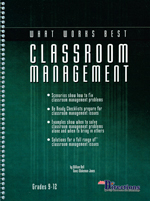
What Works Best
by William Bell and Nanci Wakeman-Jones
Few educators would argue that discipline and classroom management are the foundations for all effective teaching. When students develop the skills to become lifelong learners by managing their own behaviours, attitudes and goals, everyone benefits. This handbook is a guide to management strategies that are both practical and proactive.
Various situations that threaten to impede learning – such as failure to complete homework, plagiarism, vandalism, fighting and verbal threats – are outlined. Following each scenario is a chart that indicates the possible root causes. A Quick Fix section offers strategies to de-escalate conflict, while the Long Term Fix suggests strategies that have broader implications for the school community as a whole.
Suggested proactive measures include establishing classroom norms and consequences, considering the classroom layout and geography in order to plan seating that maximizes learning and minimizes distractions, creating gender-compatible learning goals, grouping students, building a positive and open rapport in the classroom and developing lessons that engage learners at all levels.
What Works Best: Classroom Management, Grades 9–12, Data Based Directions, Barrie, 2009, softcover, ISBN 978-1-894369-08-4, 94 pages, $64.95 (school master copy), tel 1-800-765-6966, www.databdirect.com
Anjana Thom, OCT, is an elementary resource teacher with the Peel DSB. Getting Dads on Board
Getting Dads on Board
by Jane Baskwill
Getting Dads on Board extends the ongoing conversation about gender roles and literacy from the point of view of parental collaboration and explores ways to involve fathers in their children’s reading and writing.
Jane Baskwill argues that even though traditional parenting roles have blurred in recent years, fathers’ engagement with school-based issues still lags behind that of mothers. She suggests that bringing dads in will have a positive impact on a child’s academic achievement, motivation and self-esteem.
Moreover, it will reinforce for fathers how their involvement can strengthen the parent-child relationship.
The book includes stories told by 11 dads that emphasize the powerful lessons they learned about themselves and their role in their child’s literacy learning. The suggested activities demonstrate strategies for reading aloud and for writing and hosting workshops to recruit dads. For each strategy
Baskwill provides a useful Dear Dad letter to send home with students to encourage their father’s participation.
Getting Dads on Board: Fostering Literacy Partnerships for Successful Student Learning, Pembroke Publishers, 2009, softcover, ISBN 978-1-55138-234-0, 128 pages, $24.95, tel 905-477-0650 or 1-800-997-9807, www.pembrokepublishers.com
Caroline Cremer, OCT, is a Grade 3 teacher at Leslieville Junior PS in Toronto and an AQ course instructor at Queen’s University in Kingston.
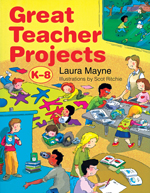 Great Teacher Projects, K–8
Great Teacher Projects, K–8
by Laura Mayne
illustrations by Scot Ritchie
This is a treasure trove of more than 75 tried-and-true, class-tested projects in many subject areas of the Ontario curriculum – projects that will build and stretch the knowledge of all your students. The activities are easy to follow and can be adapted to suit multiple learning styles.
Differentiated activities provide tiered lessons in many of the projects. For example, in one activity, the goal for Primary students is to learn to recognize the alphabet, whereas for advanced students, it is to research the history of the alphabet. One school-wide activity is designed to involve students and parents in sharing their family cultures and customs. Comprehensive lists of resources and web sites offer valuable extensions to the projects. Eye-catching illustrations enhance the text.
This book is a must-have for your library. Whether you are a veteran teacher or new to the profession, the book and its creative pedagogy will inspire and enrich your teaching style.
Great Teacher Projects, K–8, Boston Mills Press, Erin, 2009, softcover, ISBN 1550465104, 160 pages, $24.95, distributed by Firefly Books, tel 416-499-8412 or 1-800-387-6192, www.fireflybooks.com
Cheryl Woolnough, OCT, is a Special Education elementary teacher at Castlemore PS with the Peel DSB.
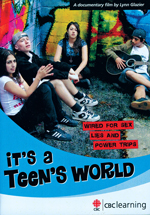
It’s a Teen’s World (DVD)
produced and directed by Lynn Glazier
This 75-minute video honestly examines how and why teenagers go to such extremes to be seen by peers as “cool.” It explores the relationship between media and personal technology and the opportunities they offer for immediate and harsh harassment. Geared to Grades 7 and up, the film contains candid dialogue and some language and visuals that may raise eyebrows – including partial nudity, hip thrusting and several questionable clips from YouTube postings by young women. But it is packed with honest material and interviews with Toronto teens and adults. We meet Amrit, who provides a window into an Indo-Canadian family, and Marta, who lives in a shelter. We also hear about rainbow clubs, climbing the social ladder, honesty boxes and the trials of fitting in. The DVD describes the issues and suggests ways to deal with them.
A three-part radio documentary from CBC’s Ideas is available on a related CD, and a web site at www.itsateenworld.com is packed with resources to use as a precursor and follow-up to viewing the video, including a 30-question attitudinal survey, a resource guide for teachers and three interactive, student-produced modules that promote honest discussion.
This invaluable DVD and the accompanying resource materials have direct relevance to various parts of the Ontario curriculum and offer teachers a remarkable road map to help their students navigate the thorny, super-sexualized social world they live in.
Pre-screening is imperative, and consideration of the viewing audience is critical. Principals may suggest that teachers send an information letter home to parents.
It’s a Teen’s World: Wired for Sex, Lies and Power Trips (DVD), Teensworld Productions, CBC Learning, 75 minutes, $132 circulating edition, $66 individual schools, tel 1-866-999-3072, www.cbclearning.ca
Cindy Matthews, OCT, is a vice-principal in the Rosemount family of schools under Section 23 in Kitchener. Learn to Speak Music
Learn to Speak Music
by John Crossingham
illustrated by Jeff Kulak
Do you know any students who have musical talent and dream about writing, performing and recording music? This might be the inspirational book for them. This is not a book of music instruction. Rather, it offers a wealth of tips to help students transform themselves into budding artists. Starting at the beginning, with advice on obtaining an instrument, the book moves through how to learn music, how to form a band, write music, play live, advertise and record.
John Crossingham writes from his experience as a Canadian indie recording artist (from Broken Social Scene) and draws in many examples of other musicians – all the way from Beethoven to Feist, Queen, the Beatles and Coldplay. Useful technical information scattered throughout the book covers topics such as song structure, planning a gig, staging components, basics of recording and making a video. The last section offers style tips on popular instruments.
The format and language is informal and engages the tween/teen reader with its conversational style. Colour cartoon illustrations, charts and sidebars support and build on the text. Crossingham’s intent is to encourage young people to pursue music because “in each of us exists a weird little musical animal waiting to be discovered.” With this accessible book, he is sure to fulfill his intent.
Learn to Speak Music: A Guide to Creating, Performing, and Promoting Your Songs, Owlkids Books, Toronto, 2009, softcover, ISBN 978-1-897349-65-6, 96 pages, $19.95, distributed by Raincoast Books, tel 1-800-663-5714, www.raincoast.com
Margaret Grift is a library consultant at Brantford Christian School.
Tumbleweed Skies
by Valerie Sherrard
This is a moving and subtle novel about a 10-year-old motherless child, Ellie, who lives in an accurately rendered rural Saskatchewan of 1954. In this hardscrabble world Ellie strives to please her embittered grandmother. Grandma disowned her only daughter, Maggie, when she eloped in 1944 with the man who became Ellie’s father. For 10 years after his wife’s death in childbirth, Ellie’s dad was a single parent. Now, laid off from his job in a mill, he starts travelling for a cookware company and needs a place for Ellie to stay while he is on the road.
As is typical in a society less child-focused than ours, Ellie minds her manners and does her best to get along. She is diplomatic, unassertive and obedient. From her Uncle Roger, a farmer disfigured in a barn fire, Ellie learns more about her mother. Tumbleweed sky was her mother’s phrase for cloud clusters before rain. The clouds, she said, were like people who have forgotten how to love. With stoicism and resolve, Ellie tackles her grandmother’s housework assignments, rehabilitates an injured magpie, rescues a duplicitous neighbour and gradually melts Grandma’s heart around the edges.
This gentle, insightful book does not have a Hollywood ending. Rather, it is realistic and open-ended. Tumbleweed Skies is one of the best orphan child novels since Anne of Green Gables.
Tumbleweed Skies, Fitzhenry and Whiteside, Markham, 2009, softcover, ISBN 978-1-55455-113-2, 153 pages, $12.95, tel 905-477-9700, www.fitzhenry.ca
Ruth Latta, OCT, is an author and educator who teaches writing courses in Ottawa.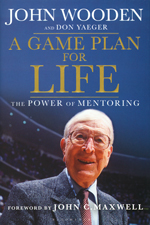
A Game Plan for Life
by John Wooden and Don Yaeger
John Wooden began life as a poor farm boy, became a teacher and high school basketball coach, and ended up as the most successful basketball coach in the history of the National Collegiate Athletic Association, leading the UCLA Bruins to 665 victories and 10 championships in the years leading up to 1975. Wooden is now 98. This is his tenth book on coaching and mentoring.
“Mentoring can be any action that inspires another,” he writes, because for Wooden, mentoring is just another word for teaching. The book is structured around seven people whom he claims as personal mentors. These include his father, early basketball coaches and figures like Abraham Lincoln and Mother Teresa. Personal testimonies by people who were mentored by Wooden – famous athletes like Bill Walton and Kareem Abdul-Jabbar – fill the second half of the book. One of the most moving testimonials comes from an Ontario basketball coach who has never met Wooden and knows him only through his books.
A Game Plan For Life not only invites readers to reflect on extraordinary individuals who have been their mentors but challenges them to become mentors themselves. While this book might hold particular appeal for athletic coaches (many of Wooden’s analogies and anecdotes are sports related), it is one of the most inspiring books on mentoring that I, as an English teacher, have read. The introductory chapter alone is worth the price of the book.
A Game Plan for Life: The Power of Mentoring, Bloomsbury, New York, 2009, hardcover, ISBN 978-1-59691-701-9, 191 pages, $31.00, tel 1-888-330-8477, www.bloomsburyusa.com
Michael Reist, OCT, is head of English at Robert F. Hall Catholic SS in Caledon East.
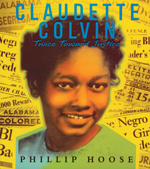
Claudette Colvin
by Phillip Hoose
If anyone mentions the civil rights movement or the bus boycott in Montgomery, Alabama, one name that immediately comes to mind is Rosa Parks. Who ever heard of Claudette Colvin? Phillip Hoose has, and he documents a story that shines a light on the events that preceded the famous bus boycott and shows how Colvin’s action connects to the civil rights movement, Martin Luther King, Rosa Parks and the National Association for the Advancement of Colored People.
Biographer Hoose tells Colvin’s story, weaving her own words into a powerful personal narrative that places the bus boycott into a wider context. The young Colvin, who found herself isolated and ridiculed by her peers, was charged and found guilty for standing up for her rights months before Rosa Parks put her stamp on history.
Full of pictures, sidebars and copies of original documents, this book chronicles the events of that turbulent period in American history. It can be used as a catalyst for multi-layered discussions about myriad social values and issues: ageism, classism, elitism, marginalization and racism. Suitable for students in Grades 7 to 12, it vividly depicts the role young people can play and have played in the struggle for freedom and social justice.
The book ends with Colvin’s return to her high school in Montgomery in 2005 to speak to students. Rosa Parks is the name the world knows, but it all started when Claudette Colvin, a teenager, refused to give up her seat.
Claudette Colvin: Twice toward Justice, Farrar, Straus and Giroux, New York, 2009, hardcover, ISBN 078-0-374-31322-7, 144 pages, $24.95, distributed in Canada by D&M Publishers, tel 416-537-2501, www.dmpibooks.com
Marguerite Alfred, OCT, is a retired vice-principal with the Toronto DSB.
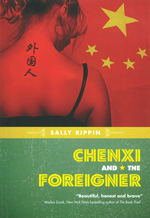
Chenxi and the Foreigner
by Sally Rippin
Chenxi and the Foreigner is set in the late 1980s during the tense time in China leading up to the Tiananmen Square massacre. When 17-year-old Anna graduates from high school in the United States, she goes to live with her father in Shanghai. Wanting her to experience the daily reality of Chinese life, her father hires Chenxi to be Anna’s guide and translator. Anna is initially thrilled by the good-looking young man but soon discovers that Chenxi does not share her attraction.
Through her time with Chenxi, Anna comes to discover how different her American ideas of freedom are from those of Chinese youth. Chenxi’s attitudes toward art have already angered the local governing group. They watch him carefully and set out to get rid of disruptive artists. Anna is puzzled by this rigid regime and voices her bewilderment to Chenxi, who is enticed by her brashness.
Chenxi and the Foreigner provides an authentic look at teen life in China by an author who spent her teen years there. It is an excellent study of culture clash and would be an exemplary novel for an English class analysis.
Chenxi and the Foreigner, Annick Press, Toronto, 2009, softcover, ISBN 978-1-55451-173-0, 224 pages, $10.95, distributed by Firefly Books, tel 416-499-8412 or 1-800-387-6192, www.fireflybooks.com
Gail Lennon, OCT, is a teacher with 35 years experience in JK through university. She presently works for a tutoring business.
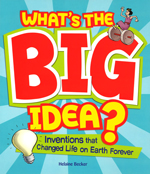
What’s the Big Idea?
by Helaine Becker
illustrated by Steve Attoe
The pages of this book are packed with informative anecdotes and crisp, humorous pictures of more than 30 inventions that have changed life on earth, from the early times of the hunter-gatherer to the high-tech humans of today.
The world of inventors and inventions is an odd and quirky one. What may have started out as an invention made specifically for one purpose often spins off into quite a different surprising or entirely unexpected application. Shouting “Eureka!” and then reaping the benefits in fame and fortune is not always the lot of an inventor. Many toil in their laboratories for years only to have someone else claim the credit. Yet inventors persevere, with the hope of creating the next great innovation.
What is clear is that all inventors share a few key characteristics. They are keen observers of natural phenomena and see connections that may not be evident to others. They test and retest their theories and hypotheses. They collaborate with others, magnifying their chances of success. Who knows – with inspiration from this book, students may be motivated to become the creators of the next big idea and line themselves up with the likes of Alexander Graham Bell, Thomas Edison or Steve Jobs.
What’s the Big Idea? Inventions That Changed Life on Earth Forever, Maple Tree Press, Toronto, 2009, softcover, ISBN 978-1-897349-61-8, 96 pages, $19.95, distributed by Raincoast Books, tel 1-800-663-5714, www.raincoast.com
Connie D’Souza, OCT, teaches at St. Bonaventure and Pauline Vanier Catholic Schools in Brampton.

